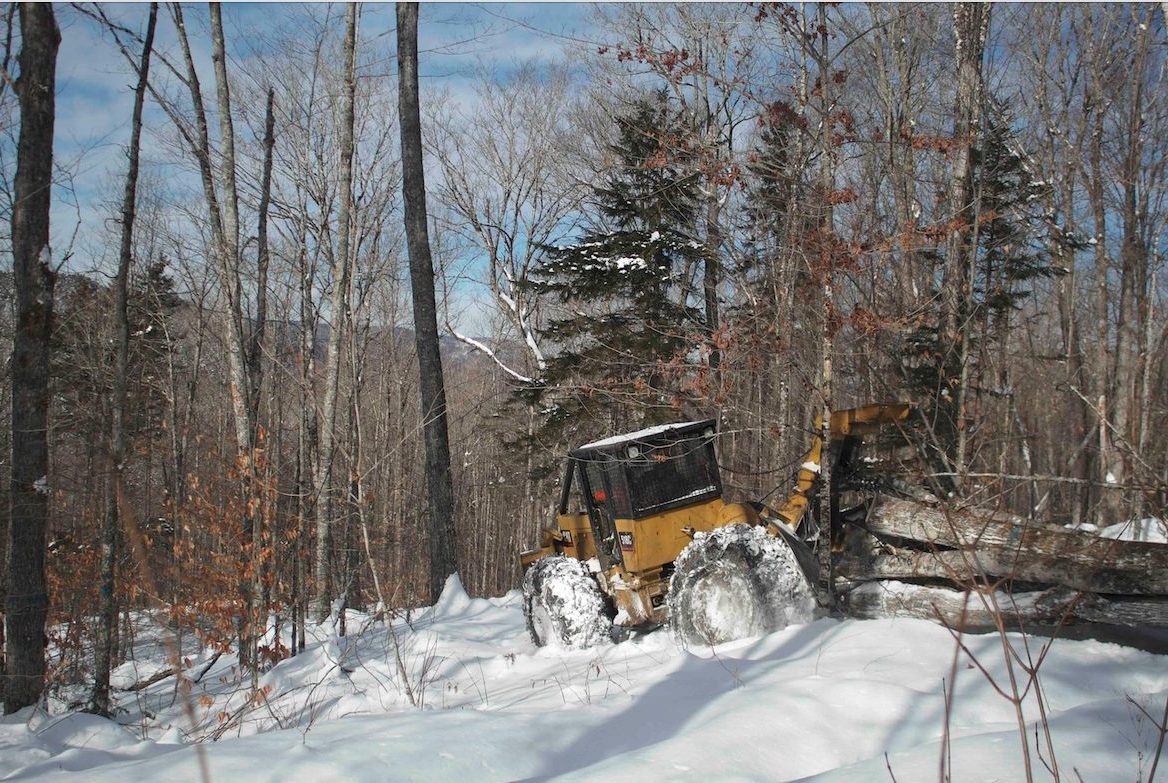Wood Products
Dartmouth College's "Forest to Dorm" Project
Story and Photos By Ross Caron

At the start of this fall semester, students who moved into Dartmouth College’s Andres Hall were greeted with beautiful brand-new wooden furniture made from trees harvested on Dartmouth’s own land. Each student in the dorm was issued a bed, desk, dresser, and bookcase made from sugar maple cut last winter on Dartmouth’s Second College Grant, (the Grant), a 27,000-acre tract located in northern New Hampshire.
In fact, every room in every dorm at Dartmouth is outfitted with furniture made from logs cut on the Grant as well as some additional trim and furniture around the college, including tables in the President’s conference room, Provost Office desks, cabinets, and conference table, and furniture and paneling at Dartmouth Skiway.
The project goes back 25 years to the winter of 1998 when 60,000 board feet of sugar maple logs were harvested, sawed, dried, and made into furniture for several dorms including Andres Hall which, at the time, was newly built. The project was a success, and it continued for the next seven years with a total of 200,000 board feet being cut and made into furniture for the rest of the dorms during that time.

According to Dartmouth College Forester Kevin Evans, the idea was Woody Eckels’s, then Head of Residential Life. “It was a big change for us,” explains Evans, “because all the dorms had traditionally been red oak.” Hard maple and yellow birch samples were sent to the college and the possibility of using beech was discussed. The college eventually decided to go with maple, mostly because of its availability as a common sawlog species on the Grant.
Because of wear and tear, Dartmouth has planned to re-fit individual dorms every 20 to 25 years, and in the winter of 2023 the college started the process again for Andres Hall. The logs harvested for this year’s project came from the very same location that provided the wood for the 1998 project.
This stand, located about 8 miles north of the main gate, like many of the hardwood stands on the Grant, was heavily cut and high-graded in the 1960s. Evans says that “as a consequence, we started growing pulpwood exponentially (throughout the Grant) and it’s taken a long time to shift that to having a higher percentage of sawlogs.” Evans, who has been Dartmouth’s forester for the past 31 years, has worked to continuously improve the quality of Dartmouth’s forestland. Timber cruise data shows that in 1967 the Grant had only 3 million board feet of sawlogs on the property. By 1998 it was up to 40 million, and it is currently at 52 million. At this volume, and with a current growth rate of 0.36 cords per acre per year, Evans estimates the sustainable harvest of sawlogs to be 750,000 board feet annually.
On a cold winter morning in January, independent logger Bryan Lambert of Berlin, NH, was cutting a marked thinning in this well-formed northern hardwood stand. The cold was a welcome change from the unseasonably warm winter we’d been having so far, and he was working to freeze in some trails to the back of the piece.

Lambert graduated from Berlin High School’s forestry program in 1990 and has been logging ever since. “I graduated on Friday and was logging on Monday,” he recalls. He enjoys the solitude and says, “I’m happiest and most at home in the woods.” He credits high school forestry instructor Tom Alt and some French-Canadian loggers he worked with early in his career for much of the training and logging knowledge that has helped him succeed in the business. Lambert uses Husqvarna 562 chainsaws and runs a 1993 CAT 518C skidder purchased from local logging contractor Mike Kelley, owner of Kel-log Inc. Lambert notes that the machine “was taken good care of.”
Most years he logs about 30 weeks on the Grant and generally produces four trailer loads of product per week. Bert Drouin, of Gorham, NH, handles his slashing, loading, and trucking. Lambert says he enjoys cutting marked wood and finds it satisfying to look back through a completed piece. It took him about three weeks to accumulate the 12,000 board feet of no.1 and better maple sawlogs needed for the Andres Hall project. Evans estimates the average age of those trees to be between 100 and 125 years old.
By March, the maple logs Lambert cut in January had been trucked out of the woods and were being sawn at DCI Sustainable Hardwood Furniture’s sawmill in South Royalton, VT. DCI is a vertically integrated company that manufactures institutional furniture at three US locations, with the main market for their products being colleges and military bases. Their headquarters is in Lisbon, NH, which is also home to the plant where the furniture for Andres Hall was made.

At DCI’s sawmill in Vermont, about 60 miles south of the Lisbon, NH plant, 10,000 board feet of ash, red oak, hard and soft maple, or yellow birch is sawn daily using a double-cut band headsaw, with no resaw. This volume happens to be about the same amount used daily at their Lisbon manufacturing facility. After being sawn at the South Royalton, VT mill, lumber is shipped to Lisbon for drying and processing. Kiln time for maple is about two weeks. Logs are often delivered to Lisbon and then backhauled to the sawmill on the returning lumber truck. One of the reasons Dartmouth contracts with DCI for their dorm projects is because of the company’s local setting. Minimizing the movement of logs and lumber and staying within a core area of the college is important for Dartmouth’s sustainability mindset.
With the start of Dartmouth’s fall term coming fast, by mid-August DCI’s plant was working hard to meet their deadline to have the furniture built and installed before move-in day.
Henry Kober, owner and founder of DCI, describes the plant’s operational model as “high mix, low volume” where the furniture is all “made to order.” DCI currently employs 160 workers at their Lisbon, NH location, running one full shift and a second partial shift. The plant burns wood scraps, chips, and sawdust produced during the manufacturing process to run the kilns and heat the buildings. Design and engineering are done in-house.
 Nelson Sweeney, former long-term DCI employee and current independent sales representative, says putting together multiple custom orders simultaneously (as many as 15) is a complex process. Computer software creates a panel list and individual boards are run through automated rip and cut-off saws where the cutting decisions are based on that panel list. The cuttings are grouped together by items and sent to different manufacturing stations throughout the building. All parts or panels then go through a finishing process before being assembled into a final product. It takes approximately four weeks from the rough mill, to the kilns, to final assembly. Output is generally two trailer loads of furniture daily.
Nelson Sweeney, former long-term DCI employee and current independent sales representative, says putting together multiple custom orders simultaneously (as many as 15) is a complex process. Computer software creates a panel list and individual boards are run through automated rip and cut-off saws where the cutting decisions are based on that panel list. The cuttings are grouped together by items and sent to different manufacturing stations throughout the building. All parts or panels then go through a finishing process before being assembled into a final product. It takes approximately four weeks from the rough mill, to the kilns, to final assembly. Output is generally two trailer loads of furniture daily.
By the first week of September, the furniture made from the maple harvested on the Grant was installed in all 92 rooms of Andres Hall, just in time for students to move in. Evans finds the project – from forest to sawmill to dorm – especially satisfying. “For me, it’s something tangible. Most of my wood leaves and I don’t know where it goes or what it gets made into. This I get to actually see.”

